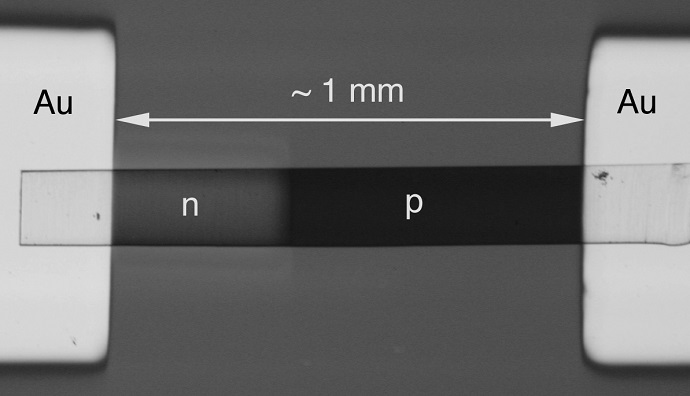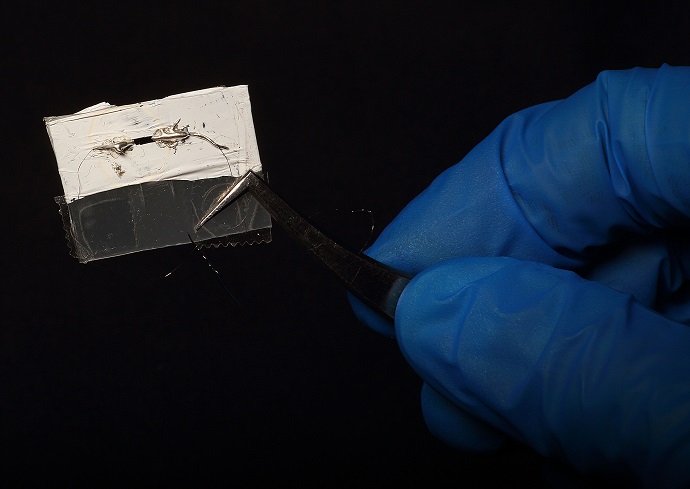HOUSTON – (June 11, 2014) – Researchers at Rice University, Sandia National Laboratories and the Tokyo Institute of Technology have developed novel terahertz detectors based on carbon nanotubes that could improve medical imaging, airport passenger screening, food inspection and other applications.
Unlike current terahertz detectors, the devices are flexible, sensitive to polarization and broad bandwidth and feature large detection areas. They operate at room temperature without requiring any power.
The project led by Rice physicist Junichiro Kono and Sandia scientist François Léonard takes advantage of the terahertz range of the electromagnetic spectrum.
Because terahertz waves are much smaller in energy than visible light, finding materials that absorb and turn them into useful electronic signals has been a challenge, Kono said. Now, thin films of highly aligned carbon nanotubes developed at Rice have been configured to act as compact, flexible terahertz sensors.
The research was reported in the American Chemical Society journal Nano Letters.
Kono said terahertz waves easily penetrate fabric and other materials and may provide less intrusive ways for security screenings of people and cargo. Terahertz imaging could also be used to inspect food without adversely impacting its quality.
Perhaps the most exciting application offered by terahertz technology, he said, is as a possible replacement for magnetic resonance imaging (MRI) technology in screening for cancer and other diseases.
“The potential improvements in size, ease, cost and mobility of a terahertz-based detector are phenomenal,” Kono said. “With this technology, you could conceivably design a handheld terahertz detection camera that images tumors in real time with pinpoint accuracy. And it could be done without the intimidating nature of MRI technology.”
The scientific community has long been interested in the terahertz properties of carbon nanotubes, Léonard said, but virtually all of the research to date has been theoretical or computer-model-based. A handful of papers, including several by Kono and his Rice team, have investigated terahertz phenomena in carbon nanotubes, but those have focused mainly on the use of one or a bundle of nanotubes.
The problem, Léonard said, is that terahertz radiation typically requires an antenna to achieve coupling into a single nanotube, due to the relatively large size of terahertz waves. The researchers, however, found a way to create a small detector that is visible to the naked eye. The thin carbon nanotube film developed by Rice chemist Robert Hauge and the paper’s lead author, Rice graduate student Xiaowei He, does not require an antenna, and is thus amenable to simple fabrication. It represents one of the team’s most important achievements, Léonard said.
“Carbon nanotube thin films are extremely good absorbers of electromagnetic light,” he explained. In the terahertz range, the film, a mix of metallic and semiconducting nanotubes, soaks up all of the incoming terahertz radiation.
“Trying to do that with a different kind of material would be nearly impossible, since a semiconductor and a metal couldn’t coexist at the nanoscale at high density,” Kono said. “But that’s what we’ve achieved with the carbon nanotubes.”
The technique is key, he said, because it combines the superb terahertz absorption properties of metallic nanotubes and the unique electronic properties of semiconducting nanotubes. This allowed the researchers to create a photo detector that does not require power to operate, with performance comparable to existing technology.
The 150-micron-wide, 2-millimeter-long films of aligned carbon nanotubes were grown by He from 2-micron-wide lines of catalyst. The resulting film was doped to create a positive/negative junction and attached to Teflon backing and gold electrodes for testing. “The structure is very compact and combines the absorber, the thermometer and polarizer that terahertz detectors require into one piece of film,” He said.
Next, the researchers need to integrate an independent terahertz radiation generator with the detector for applications that require a source, Léonard said. The team also needs to incorporate electronics into the system and to further improve properties of the carbon nanotube material.

A nanotube detector attached to two gold electrodes is able to detect terahertz waves. The nanotubes are doped to provide negative and positive regions. The detector developed by Rice University, Sandia National Laboratories and the Tokyo Institute of Technology could improve many imaging applications. (Credit: Kono Laboratory/Rice University)
The project’s contributors included researchers taking part in NanoJapan, a 12-week summer program that enables freshman and sophomore physics and engineering students from U.S. universities to complete nanoscience research internships in Japan. NanoJapan is funded by the National Science Foundation through the TeraNano collaboration based at Rice and Tokyo Tech. Such research collaborations and international outreach are among Rice’s Priorities for the New Century.
“A hallmark of this international research collaboration is the emphasis it places on training the next generation of terahertz nanoscience researchers,” Kono said. “NanoJapan tightly integrates the international experience with students’ academic programs by providing hands-on opportunities to acquire technical skills and knowledge associated with cutting-edge nanoscience and optics research projects.”
Co-authors are Rice graduate students Qi Zhang, Weilu Gao and undergradute Qijia Jiang; Naoki Fujimura and Yukio Kawano of the Tokyo Institute of Technology; NanoJapan participant Meagan Lloyd of Carnegie Mellon University; Kristopher Erickson and Alec Talin of Sandia National Laboratories; and Hauge, a distinguished faculty fellow in chemistry at Rice. Kono is a professor of electrical and computer engineering and of physics and astronomy.
The Department of Energy, the National Institute for Nano Engineering at Sandia National Laboratories, the Lockheed-Martin Rice University LANCER program, the National Science Foundation and the Robert A. Welch Foundation funded the research.















